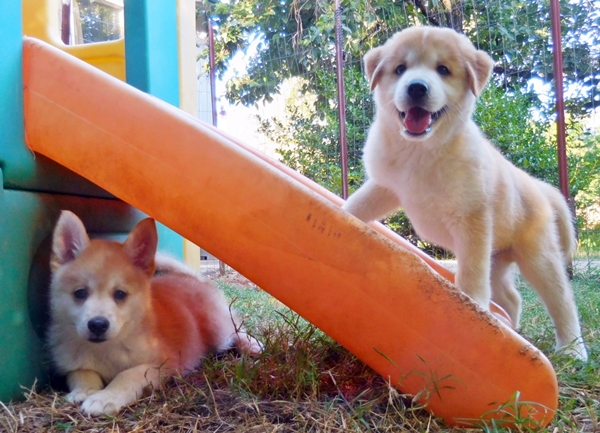Five Tips Before You Begin Pomsky Training

Welcome to part two of our pomsky training mini-series. In this mini-series, we’re giving you bits and pieces from our Pomsky Training Book to help you train the perfect pomsky.
This is just part two of the five part pomsky training mini-series. You can access the other parts of our training series here:
- Part 1: How to train a Pomsky (the method that works)
- Part 2: 5 tips before you begin Pomsky training
- Part 3: The most important aspect of Pomsky training
- Part 4: The top two commands to teach your Pomsky today
- Part 5: The 3 Pomsky behaviors to correct and train
Pomsky training tips
Here are a couple tips straight from the breeder. These are must read tips BEFORE you begin training. Listen to the pomsky breeders, they’ve been there before, learn from their mistakes and their experience.
Five pomsky training tips:
- Start young
- Use treats
- Keep sessions short
- Be consistent
- Teach engagement
Start Young
Start training as soon as your pomsky comes home. The younger your pomsky is the easier it will be to train. Your pomsky needs to know at a young age that the owner is the one that provides value. When the pomsky behaves, the owner is the one that provides praise, the owner gives treats and the owner decides when the pomsky can play. Remember to start with the basics. Get the basic behavioral training and commands down first; these are absolutely the most important aspect of a well-behaved pomsky, don’t get too excited about teaching your pomsky party tricks. As Lauren of Pristine Pomskies says, “Even though they may be boring they are crucial to the harder commands. Don’t expect your dog to learn 5 new commands in one day. Understanding that the process is slow is important. Training cannot be rushed.”
Training a pomsky is a lifelong task. It’s important to start small and work your way up. Start with the priorities such as recall, sit, stay, where to potty, when to eat and not to beg. Once you master the simple commands and behaviors, it will be much easier to move onto the complex tricks and advanced commands.

Use Treats
Treats are an effective method of keeping your pomsky’s attention. Think of treats as a training tool, not a bribe. Use treats to your advantage and teach your pomsky early that they will be rewarded for behaving. As Kanzaidy of SZ Pomskies says “Most Pomskies are highly food motivated. Use that to your advantage when training and trying to keep their attention.” We highly recommend using treats to train your pomsky.
Keep Sessions Short
Short training sessions always work best. Training is mentally stimulating, you don’t want your pomsky to tire and become frustrated with the training. Keep your training session short, no longer than 10 to 15 minutes a couple times per day. Any longer than 15 minutes and you run the risk of doing more damage than good, you’ll lose your pomskies attention and you’ll end up teaching the pomsky to be distracted rather than engaged.
So as you can see the training process won’t take all your spare time. In this case, even a busy essay writer, teacher, student, business owner, or office worker will find some time for a training session.
Be Consistent
Consistency is key. Pomsky breeders agree that lack of consistency is the number one biggest reason that pomsky owners fail to train their pomskies. Consistency means you start training and stick to it. You should be consistent in all of the following:
- Technique
- Schedule
- Situations
- Commands
- Among family
These aspects of consistency are key to a successful training program, as Cheyenne of Lollipop Pomskies says, “Consistency is not only setting an appropriate schedule, consistency is behaving, in the same way, each time you interact with your Pomsky.” If you’re not consistent with your pomsky, your training efforts will fail. The pomsky is an incredibly intelligent breed. If you’re not focused and dedicated to training, your pomsky will walk all over you (both figuratively and literally). According to Lauren of Pristine Pomskies “If an owner is not consistent, their Pomsky will quickly learn that commands are optional. This allows them to ignore and disrespect you.” Without consistency, your pomsky will form bad habits, not because your pomsky is bad but because your pomsky will not understand what is right and what is wrong.”
We will discuss this more in part 3 of the pomsky training series where we break down exactly how to keep consistent with your pomsky training efforts.
Download Now – Pomsky Training and Owners Guide
Teach Engagement
Engagement means having your pomskies complete attention. Whether you are training, giving a command or playing  with your pomsky, engagement means your pomsky is completely and totally focused on you. A pomsky that is engaged wants to be with you and wants what you have, whether you have a favorite toy or a treat, the pomsky is fully focused on you and only you. An engaged pomsky is more interested in you than anything else in the world. Without engagement it’s impossible to even begin training your pomsky; if your pomsky is not engaged they will not learn, they will never be fully trained, and the future behavior of the pomsky will be jeopardized. As Jo of Moonlit Pomskys says, “if you don’t have your dog’s eyes you don’t have your dog”.
with your pomsky, engagement means your pomsky is completely and totally focused on you. A pomsky that is engaged wants to be with you and wants what you have, whether you have a favorite toy or a treat, the pomsky is fully focused on you and only you. An engaged pomsky is more interested in you than anything else in the world. Without engagement it’s impossible to even begin training your pomsky; if your pomsky is not engaged they will not learn, they will never be fully trained, and the future behavior of the pomsky will be jeopardized. As Jo of Moonlit Pomskys says, “if you don’t have your dog’s eyes you don’t have your dog”.
Some pomsky owners refer to this as “respect” because a disengaged pomsky appears disrespectful, ignoring your commands and disregarding you in general. This is a common misconception. Your pomsky is not disrespecting you; it’s just not engaged with you. Your pomsky has learned that other things are more interesting than what you have to offer.
Engagement must be taught before any other training. Pomskies that learn engagement as their first behavior become much easier to train; it creates a positive attitude towards learning and training and creates a stronger bond between the pomsky and owner. Here is one way to teach your pomsky engagement. In this process, we’re teaching the pomsky that in return for engagement, they will be rewarded with a treat:
- Step 1: Take a handful of treats and hold it in a fist. Let the pomsky sniff your hand to figure out that you are holding treats.
- Step 2: Continue holding your hand with treats closed in a fist until the pomsky realizes that sniffing and begging won’t make you open your hand. This teaches the pomsky that they won’t get what they want by sniffing and begging.
- Step 3: When the pomsky pulls their head away in defeat, open your hand to show the treats. This teaches the pomsky that acting in a certain way (by backing away) will get you to open your hand.
- Step 4: The pomsky will likely lunge at your hands once they see the treats, close your hand and don’t let the pomsky get any treats. Continue this until the pomsky sits back and allows you to fully open your hand showing the treats. This teaches the pomsky that they won’t get what they want by lunging for the treats.
- Step 5: Once your pomsky is sitting back and allowing you to open your hand fully displaying the treats, use your other hand to slowly grab a treat from your open palm and slowly give your pomsky a treat. If at any time your pomsky lunges for the treats or attempts to snatch the treat from your hand while giving the treat, put the treat back and close the treats in a fist. Repeat this until the pomsky learns that they must sit back to receive a treat. This teaches the pomsky they will not get a treat by lunging, they need to wait for you to deliver the treat.
- Step 6: Once the pomsky behaves and appropriately waits while you reach into your hand to grab a treat, reward the pomsky with a treat and mark the behavior with a positive phrase such as “Yes” or “Good dog”.
- Step 7: Repeat this process. Close your hand and do not reward the pomsky if they misbehave. When the pomsky is patient and waits for the treat, reward the pomsky.
This is just one method of teaching engagement. For more ways to teach your pomsky engagement download our free pomsky training guide.
Download Now – Pomsky Training and Owners Guide
Next Steps
Now that you’ve read through the pomsky training tips you should begin teaching your pomsky engagement, use the step by step instructions provided above to begin training your pomsky. If you need more insight, examples, and step by step instructions on how to train your pomsky check out our Pomsky Training Book.
Once you teach engagement, move onto the next part of our pomsky training mini-series:
- Part 1: How to train a Pomsky (the method that works)
- Part 2: 5 tips before you begin Pomsky training
- Part 3: The most important aspect of Pomsky training
- Part 4: The top two commands to teach your Pomsky today
- Part 5: The 3 Pomsky behaviors to correct and train
Summary
Here’s a summary of the top five training tips from pomsky breeders:
- Start young – the sooner you begin training your pomsky the easier it will be.
- Use treats – use treats to reward your pomskies good behavior. Positive reinforcement is the best way to train your pomsky.
- Keep sessions short – target two to three, 10-15 minute training session per day. Short training sessions are more effective.
- Be consistent – keep consistent. If you’re not consistent then your pomsky training efforts will fail.
- Teach engagement – if your pomsky is not engaged, it will be impossible to train your pomsky.
For additional pomsky training tips including step by step instructions on how to train engagement and important commands, download our pomsky training guide:
More Pomsky Resources
Need more help raising and training your Pomsky? Check out our other Pomsky articles and videos including:
- Free Download - Pomsky Owning and Training Guide
- Register Your Pomsky With The POA
- Article - How to Train A Pomsky
- Article - Potty Training Tips
- Video - Pomsky Training Video Series
- Video - Stop Your Pomsky From Chewing
- Article - Stop Separation Anxiety
- Article - Pomsky Health Issues
Need more help training and raising your Pomsky? Click here to download our complete guide to owning a Pomsky (Includes step by step training instructions).


